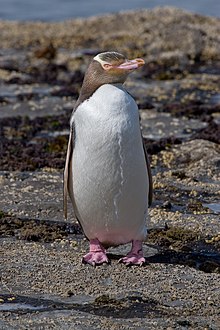Megadyptes antipodes
| Yellow-eyed penguin | |
|---|---|
 |
|
| Scientific classification | |
| Kingdom: | Animalia |
| Phylum: | Chordata |
| Class: | Aves |
| Order: | Sphenisciformes |
| Family: | Spheniscidae |
| Genus: |
Megadyptes Milne-Edwards, 1880 |
| Species: | M. antipodes |
| Binomial name | |
|
Megadyptes antipodes (Hombron & Jacquinot, 1841) |
|
 |
|
| Distribution of Yellow-eyed penguin | |
The yellow-eyed penguin (Megadyptes antipodes) or hoiho is a penguin native to New Zealand. Previously thought closely related to the little penguin (Eudyptula minor), molecular research has shown it more closely related to penguins of the genus Eudyptes. Like most other penguins, it is mainly piscivorous.
The species breeds around the South Island of New Zealand, as well as Stewart Island, Auckland Islands, and Campbell Islands. Colonies on the Otago Peninsula are a popular tourist venue, where visitors may closely observe penguins from hides, trenches, or tunnels.
The yellow-eyed penguin is the sole extant species in the genus Megadyptes. (A smaller, recently extinct species, M. waitaha, was discovered in 2008.) Previously thought closely related to the little penguin (Eudyptula minor), new molecular research has shown it more closely related to penguins of the genus Eudyptes. and nuclear DNA evidence suggests it split from the ancestors of Eudyptes around 15 million years ago.
The yellow-eyed penguin was described by Jacques Bernard Hombron and Honoré Jacquinot in 1841. The Maori name is hoiho.
This is a mid-sized penguin, measuring 62–79 cm (24–31 in) long (fourth largest penguin). Weights vary through the year being greatest, 5.5 to 8 kg (12–18 lbs), just before moulting and least, 3 to 6 kg (6.6–13.2 lbs), after moulting. The males are larger than the females. It has a pale yellow head and paler yellow iris with black feather shafts. The chin and throat are brownish-black. There is a band of bright yellow running from its eyes around the back of the head. The juvenile has a greyer head with no band and their eyes have a grey iris.
...
Wikipedia

